
Anomet Products is the leader in platinum clad anodes (platinized anodes). Anomet Platinum Clad Anodes feature all the ingredients necessary for a long life, cost effective, anode material. A low consumption rate material metallurgically bonded to a corrosion resistant inert anodic oxide forming substrate with the flexibility of high conductivity or high strength core materials.
Leadership in Platinum Anode Technology
Anomet Products has been manufacturing platinum clad anode materials since 1976, and today is the leading supplier of platinum clad anode materials. Anomet, together with its sister company, Supercon, represents umatched experience in innovative metallurgical processing. Since its inception, Anomet has been dedicated to improving product quality and to developing new products using advanced metallurgical technology to provide long lasting cost effective anode materials. Today, Anomet is recognized throughout the cathodic protection industry for its product quality and excellent service.
Platinum Clad Anode Material Selection
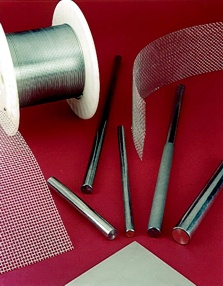
The materials chosen in the design of Anomet's anodes are based primarily on the technical merits of the metals utilized. While the list of possible material combinations is virtually unlimited, the current standard line of Anomet material limits itself to those materials which possess specific properties necessary in the design of an effective impressed current anode material.
Platinum is used on the surface as a primary anode material due to its excellent corrosion resistance under anodic conditions coupled with its ability to pass current in all electrolytes without forming an insulating film. The corrosion resistance of platinum manifests itself in its low consumption rate. Its major disadvantage is its high cost, thus making it clear that it is most desirable to use as little platinum as is necessary. In order to restrict the amount of platinum used and to maintain an anode of some structural integrity, it is necessary to use some type of substrate material.
Included among the properties of the substrate should be the ability to form an insulating film under anodic conditions, such that a dimensionally stable anode is obtained, good conductivity, and relatively low cost. As there are no individual materials which fully meet all of these criteria, it is necessary in most cases to use a combination of materials.
Both niobium and titanium have the ability to form insulating oxide films under anodic conditions, and both possess unique advantages and disadvantages as a substrate for platinum. The major advantage of titanium is its low cost, particularly when considering its lower density. Unfortunately, there are many applications where the disadvantages of titanium far outweigh its cost advantage. First, in environments with high chloride contents, the insulating oxide film formed by titanium tends to break down, thus undermining dimensional stability needed for complete platinum consumption. A second disadvantage of titanium is its poor conductivity; approximately 5 times less than niobium and 50 times less than copper. Low conductivity makes titanium poorly suited for long wire lengths and restricts its use to larger diameter, shorter anodes.
The use of niobium as a substrate to platinum eliminates many of the problems with titanium. The breakdown voltage of niobium oxide film is approximately 120 volts in most commonly found cathodic protection environments. Although its conductivity is higher than that of titanium, it is often still too low for use in small diameters and long lengths. The principal disadvantage of niobium, however, is its relatively high cost.
Copper is an ideal conductor at virtually any length and diameter suitable for cathodic protection. The combination of high conductivity and low cost allows copper to be an ideal candidate for use in the design of an anode material.
Table 1: Material Considerations in Platinum Anode Design
|
Copper (Cu) |
Good conductivity, low cost. |
|
Niobium (Nb) |
Passive film formation, high cost, high breakdown potential, fair conductivity. |
|
Titanium (Ti) |
Passive film formation, low cost, low breakdown potential, poor conductivity. |
|
Platinum (Pt) |
High corrosion resistance, high cost, good conductivity. |
In reviewing the properties of these materials (Table 1), it becomes quite clear that if a combination of these materials was developed which exploits only the advantages, the result would be a superior anode material. The most logical combination of materials would include the use of a platinum outer layer, very thin due to cost, a layer of niobium beneath the platinum to allow for a dimensionally stable anode, and a copper core for both conductivity and economy. The niobium layer should be heavy enough to withstand normal mechanical handling.
To properly manufacture an anode material which is composed of multilayers, sophisticated metallurgical processing techniques must be employed to insure integral contact between the metal layers. The ideal method of insuring this contact is by providing a metallurgical bond. All of Anomet's clad materials are manufactured through very tightly controlled metallurgical coprocessing techniques yielding complete metallurgical bonds. In obtaining this type of high integrity bonding, three materials then behave as one with no possibility of spalling or non-bonds. This method of fabrication used by Anomet insures that the corrosion engineer obtains a high quality anode material.
Standard Anode Materials Available
In order to provide faster service and greater economy, Anomet manufactures a number of "standard" anode configurations. These configurations are the result of several years of customer interaction, such that the anode designs could provide sufficient design flexibility for the engineer in a large variety of cathodic protection applications.
Anomet 20
| Anomet 20 is a standard platinized anode material which is 20% niobium by crossectional area with a copper core. Anomet 20 is available as a stock item in both single and double platinum thicknesses. The use of Anomet 20 is recommended for anode diameters of 1/8" and above. At these diameters, the niobium thickness is sufficient for most applications. Only where there are severe mechanical or unique handling concerns is a heavier niobium layer considered necessary. |
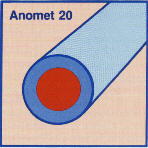 |
| Anomet 20 (20% Nb) | ||||
| Diameter | Nb Thickness | Resistance | Pt Thickness | |
| inches | inches | microhm/ft | u-in. | (2X)* |
|
.750 |
.038 |
22 |
300 |
(600) |
|
.500 |
.025 |
50 |
200 |
(400) |
|
.375 |
.019 |
89 |
150 |
(300) |
|
.250 |
.013 |
201 |
100 |
(200) |
|
.188 |
.009 |
356 |
75 |
(150) |
|
.125 |
.006 |
806 |
50 |
(100) |
| * Double platinum thickness |
Anomet 40
| Anomet 40 is a standard platinized anode material, which is 40% niobium by crossectional area with a copper core. The use of Anomet 40 is recommended for anode diameters below 1/8". The heavier niobium allows for sufficient mechanical and electrochemical protection of the copper core at these smaller diameters. Anomet 40 is sold principally at smaller diameters usually in double platinum thicknesses. It should be noted that anode life is not related to niobium thickness. |
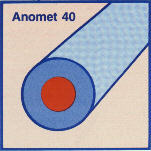 |
| Anomet 40 (40% Nb) | ||||
| Diameter | Nb Thickness | Resistance | Pt Thickness | |
| inches | inches | microhm/ft | u-in. | (2X)* |
|
.375 |
.038 |
113 |
150 |
(300) |
|
.250 |
.025 |
256 |
100 |
(200) |
|
.188 |
.019 |
453 |
75 |
(150) |
|
.125 |
.013 |
1025 |
50 |
(100) |
|
.093 |
.010 |
1822 |
38 |
(75) |
|
.063 |
.007 |
4102 |
25 |
(50) |
|
.031 |
.0035 |
16,408 |
12.5 |
(25) |
| * Double platinum thickness |
Anomet 100 Ti
| Anomet 100Ti is a platinum clad (platinized) anode material with a solid titanium core. Anomet 100Ti is available as a stock item in both single and 2-1/2 times platinum thicknesses. Titanium cored anodes are used where the lower breakdown voltage and anode conductivity are not of great concern. While smaller diameters are available, titanium is most often used in larger diameters of shorter lengths. |
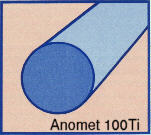 |
| Anomet 100 Ti (100% Ti) | ||||
| Diameter | Ti Thickness | Resistance | Pt Thickness | |
| inches | inches | microhm/ft | u-in. | (2X)* |
|
.750 |
Solid |
468 |
300 |
(600) |
|
.500 |
Solid |
1054 |
200 |
(400) |
|
.375 |
Solid |
1874 |
150 |
(300) |
|
.250 |
Solid |
4215 |
100 |
(200) |
|
.188 |
Solid |
7454 |
75 |
(150) |
|
.125 |
Solid |
16,862 |
50 |
(100) |
| * Two and a half platinum thickness |
Anomet 100 Nb
Anomet 100Nb is a platinum clad (platinized) anode material with a solid niobium core. Niobium cored platinum clad anodes are used where exposed ends are an issue. Although the conductivity of niobium is 5 times that of titanium, it is still better suited for larger diameters in shorter lengths. The other concern of using niobium is its higher cost. Anomet 100Nb is not readily available as a stock item however smaller pieces may be available from time to time. Please call for availabilty.
| Anomet 100 Nb (100% Nb) | ||||
| Diameter | Nb Thickness | Resistance | Pt Thickness | |
| inches | inches | microhm/ft | u-in. | (2X)* |
|
.750 |
Solid |
|
300 |
(600) |
|
.500 |
Solid |
|
200 |
(400) |
|
.375 |
Solid |
|
150 |
(300) |
|
.250 |
Solid |
|
100 |
(200) |
|
.188 |
Solid |
|
75 |
(150) |
|
.125 |
Solid |
|
50 |
(100) |
| * Double platinum thickness |
Partial Clad (Probe) Anodes
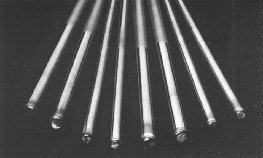
Partial clad (probe) platinum anodes were introduced as a technological innovation from Anomet, designed to provide the benefits of co-extruded metallurgically bonded materials to applications where platinum is needed to distribute current only on specific areas. Partial clad probe anodes find their greatest use in applications where it is necessary to have the current emitting surface stand off from the structure, such as in condenser water box walls. Below is a guide to selecting typical probe anode configurations. In many cases a steel core may be required in place of copper for increased mechanical strength.
Anomet Tubular Anodes
Anomet's tubular anodes are designed for applications where high anode surface area and high current output are required. Normally available in diameters of 3/4" and above, these anodes can be obtained fully or partially clad.
In previously available tubular anode designs, the principal disadvantage was the relatively heavy niobium wall thickness required to maintain structural integrity. The niobium often contributes more significantly to the cost than the platinum. Anomet's tubular anodes minimize this cost disadvantage by using a copper cored tubular substrate. The substrate consists of niobium-copper-niobium, thereby utilizing 50-60% less niobium than a conventional solid tube. In addition to cost savings, excellent conductivity is achieved.
Woven Wire Mesh Anodes
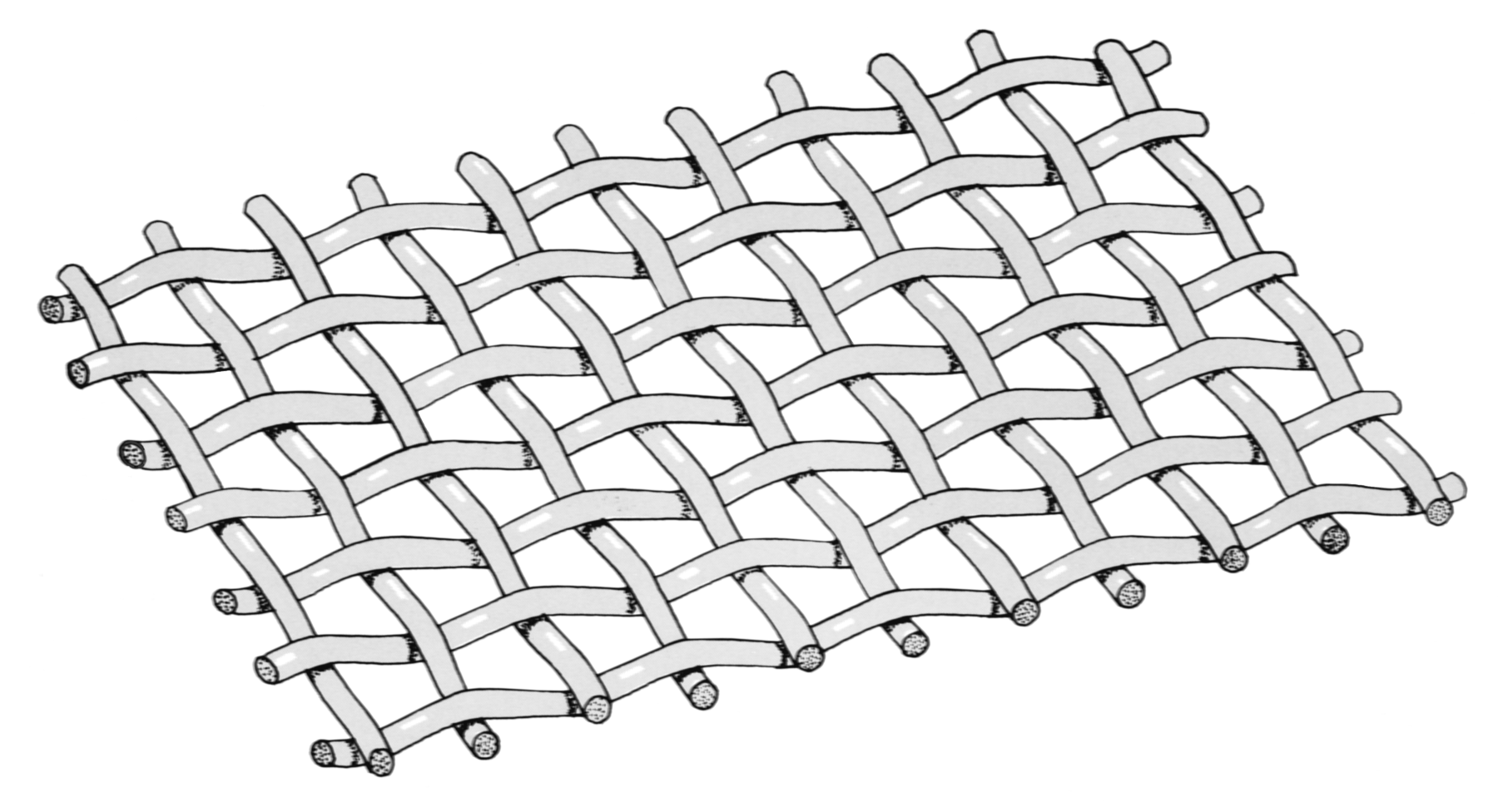
In addition to rod and wire anode geometries, Anomet provides platinum clad anode materials in sheet, strip and woven mesh. The mesh material is manufactured by weaving platinum clad niobium wires in a mesh pattern, yielding very high surface areas and no unplatinized edges.
Mesh material is produced by weaving .020" diameter platinum clad niobium wire in a 10 x 10 mesh pattern (10 wires/inch in both directions). The standard platinum thickness is 100 microinches; this would be equivalent to 125 microinches two sided expanded mesh. The working surface area of Anomet's 10 x 10 woven mesh is 1.25 in2/in2. This compares to a 2 to 1 expanded mesh working area of 1 in2/in2. This increased surface area means lower operating current densities and longer anode life. Anomet's woven mesh is available in virtually any size and may be obtained up to 36 inches wide with no joining or welding. Frames and tabs are also available.
| Anomet Standrd Pt Clad Mesh Specifications | |
|
Wire composition |
Platinum clad niobium |
|
Wire diameter |
0.020" (0.508 mm) |
|
Platinum thickness |
100 µin (2.54 µm) |
|
Mesh pattern |
10 x 10 wires/inch |
|
Active surface area |
1.25 in2/in2 |
|
Frames and tabls |
Available on request |
|
Shapes & Sizes Availabale |
|
|
Available shapes |
Cut to size |
|
Available length |
Customer specified |
|
Available width |
Up to 36 inches |
| * Double platinum thickness |
Expanded Mesh Anodes
Anomet can also provide mesh anodes in expanded mesh form using a sheet or strip material that is then expanded. The expanded mesh anode material is not readily available and must be specially ordered. Contact Anomet for more details.
Custome Anodes & Special Products
Anomet's standard anodes may not have the optimum configuration for certain applications. To meet special requirements, Anomet has full capabilities in custom design and sufficient raw material to respond rapidly to custom designs.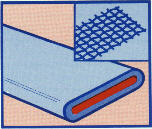
Custom anodes manufactured by Anomet include steel cored anodes, solid niobium, solid tantalum, tantalum-niobium combinations, and a large variety of custom platinum and niobium thicknesses. The metallurgical and coprocessing expertise available at Anomet provides for virtually unrestricted composite combinations. Copper Cored Hastelloy® is also available. Hastelloy alloys with which Anomet has worked include Hastelloy B2 and Hastelloy C276, also known as Cu Cored Hastelloy and Hastelloy Clad Copper. Hastelloy® is a registered trademark of Haynes International.
How to Order Standard Anodes
A) Use the above tables to select the material for the probe anode.
B) Select the appropriate probe diameter and substrate thickness from the table below:
| Substrate Thickness | |||||
| Diameter | 100Ti or 100Nb | 20% Nb | 40% Nb | Pt Thickness | |
| inches | Solid | inches | inches | u-in. | (2X)* |
|
.750 |
Solid |
.038 |
.076 |
300 |
(600) |
|
.500 |
Solid |
.025 |
.050 |
200 |
(400) |
|
.375 |
Solid |
.019 |
.038 |
150 |
(300) |
|
.250 |
Solid |
.013 |
.025 |
100 |
(200) |
| * Double platinum thickness |
C) Specify the Platinum / Non-Platinum Area (for Probe Anodes only)
Example: Anomet 40 Nb, 0.375" OD x 12" Long w/ 300 µin Pt, 6" Active Pt